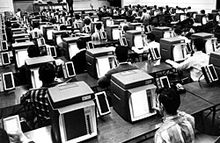From an Economist report about higher education, an astounding triumph of modern humanity but one that must change to be sustainable and effective, a passage about the forces of disruption:
Higher education suffers from Baumol’s disease—the tendency of costs to soar in labour-intensive sectors with stagnant productivity. Whereas the prices of cars, computers and much else have fallen dramatically, universities, protected by public-sector funding and the premium employers place on degrees, have been able to charge ever more for the same service. For two decades the cost of going to college in America has risen by 1.6 percentage points more than inflation every year.
For most students university remains a great deal; by one count the boost to lifetime income from obtaining a college degree, in net-present-value terms, is as much as $590,000. But for an increasing number of students who have gone deep into debt—especially the 47% in America and 28% in Britain who do not complete their course—it is plainly not value for money. And the state’s willingness to pick up the slack is declining. In America government funding per student fell by 27% between 2007 and 2012, while average tuition fees, adjusted for inflation, rose by 20%. In Britain tuition fees, close to zero two decades ago, can reach £9,000 ($15,000 a year).
The second driver of change is the labour market. In the standard model of higher education, people go to university in their 20s: a degree is an entry ticket to the professional classes. But automation is beginning to have the same effect on white-collar jobs as it has on blue-collar ones. According to a study from Oxford University, 47% of occupations are at risk of being automated in the next few decades. As innovation wipes out some jobs and changes others, people will need to top up their human capital throughout their lives.
By themselves, these two forces would be pushing change. A third—technology—ensures it.•

